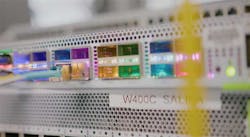As Meta begins building a digital metaverse to house a future social network, it is rolling out new networking hardware and software to power its effort. Meta – the newly renamed hyperscale data operator that operates Facebook – unveiled new networking technologies today at the Open Compute Project Summit, including a next-generation top-of-rack switch, a key component of data center networks.
The announcements at the OCP Summit are the first signs of how Meta will build upon its existing infrastructure to create a metaverse – a virtual world populated by 3D avatars
The company has invested more than $16 billion in building and operating 18 Facebook cloud campuses in the United States, which upon completion will span 40 million square feet of data center space.
That spending will clearly ramp up as Meta retools its data centers and networks for the demands of a globally-distributed virtual world that can serve a billion users or more. Meta says it expects to invest between $29 billion and $34 in capital expenditures, up from $19 billion last year.
“The metaverse will rely on many technologies, including advanced AI at scale,” the Meta team said in a blog post. “We’re only about one percent along on the journey, but the road to the metaverse will be paved with open advanced networking hardware.”
New Wedge Top-of-Rack Switches
Network hardware is front and center in Meta’s announcements at today’s kickoff of the annual OCP Summit.
Meta has worked with Broadcom and Cisco to develop next-generation versions of its Wedge top-of-rack (TOR) switches, which use custom ASICs (application specific integrated circuits) to optimize its network. The Wedge 400 will use Broadcom’s Tomahawk 3 ASIC, while the 400C uses Cisco’s Silicon One chip. Both versions offer higher front panel port density and greater performance for AI and machine learning applications.
The new switches are already deployed in Facebook data centers, and are providing four times the switching capacity over the predecessor Wedge 100S. Both Wedge 400 switches are manufactured by Celestica and are open platforms that developers can use in their own projects.
Meta says its data center network fabrics have fabrics have evolved from 100 Gbps to the next-generation 200 Gbps/400 Gbps. The company has developed two next-generation 200G fabric switches, including an update of Meta’s own Minipack2 modular network switch, as well as working with Arista Networks on the Arista 7388X5. Both are backward compatible with previous 100G switches and will support upgrades to 400G.
Migrating to OCP Switch Interface
Emphasizing its focus on open networking, Meta also said that it has migrated its data center network hardware to a standard and open API — the Open Compute Project (OCP) Switch Abstraction Interface (SAI).
“In the past, FBOSS, Meta’s own network operating system for controlling network switches, has utilized the specific API provided by the ASIC vendor,” the Meta team said. “Now, with FBOSS being adapted to OCP SAI and deployed at scale in the Meta network, we can work with more silicon vendors.
“Adapting and migrating FBOSS to SAI means we can onboard multiple ASICS from multiple vendors more quickly and easily onboard new ones in the future,” the company added. “SAI’s API lets engineers configure new networking hardware without needing to delve into the specifics of the underlying chipset’s SDK (software development kit).”
10 Years of Open Compute
The Meta team observes the 10-year-anniversary of the Open Compute Project with reflections on the success of Facebook’s open hardware initiative, as well as its ambitions for the next 10 years.
“As we look at the next decade, we want to build an open and standardized approach to solving even more of the big problems that our industry is facing collectively,” said a blog post from Meta’s Mark Roenigk, Omar Baldonado and Dharmesh Jani.
A key priority is the work of the OCP Domain Specific Architecture workgroup to develop custom chip hardware for demanding new workloads.
“Moore’s era of transistor doubling has tapered, and the industry is looking at chiplets to continue achieving the performance gains of past.,” the Meta team wrote. “We are focused on building an open and standard die-to-die interface that can be used by all in the industry to develop innovative solutions that large data center operators, including Meta, can easily integrate within our data centers.”
The hardware innovation ecosystem of the Open Compute Project will be key to building infrastructure that can handle the computing challenges of the metaverse.
“To deliver a diversity of new workloads that will be created as a result, we continue down the path of disaggregated global networks and data centers that will underpin all of this,” Meta writes. “Open hardware drives the innovation necessary to reach these goals. And our collaborations with both long-standing and new vendors to create open designs for racks, servers, storage boxes, motherboards, and more will help push Meta and the wider industry onto the next major computing platform.”






